‘…AN ACCOUNT OF THE GREAT CONTEST NOW IN PROGRESS…’

Printed and published by The Times newspaper, The Times History and Encyclopaedia of the War was a British weekly periodical first issued on 25 August 1914, only three weeks after the outbreak of war on 4 August. In the Preface to the first issue, the object of the enterprise was defined.

The Preface claimed that it would be ‘an account of the great contest now in progress’, and it would be ‘at once popular and authoritative’. It would be ‘popular in the best sense of the word’, and discuss the political factors which have led up to the crisis’, and serve ‘as a work of reference’.
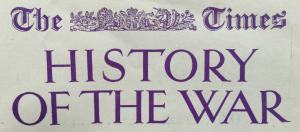
As far as writing was concerned, the publisher spoke of its ‘staff of foreign correspondents […] celebrated for the knowledge and insight into political and social conditions’. These correspondents had made ‘the foreign pages of The Times the most accurate review of current foreign affairs published in any paper in the world’. The Times had ‘succeeded in obtaining the services of writers well versed in Military and Naval affairs and foreign political matters’.

The Times History and Encyclopaedia of the War was to be issued ‘weekly in sevenpenny parts’ (7d in 1914 being roughly £3.00 in 2016), and thirteen parts were to form one volume. Special bindings were to be offered ‘in three different qualities’ – cloth, half leather, and full leather – to be ‘sold by every bookseller’. Modern 2016 prices for these various ‘qualities’ would be cloth £7.75, half leather £14.25, and full leather £26, roughly.
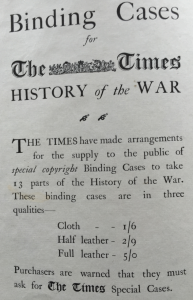
Ad’ for the special binders that were available in which to gather the weekly parts of ‘The History’. From Volume 1, Part 2, p.ii.
The weekly parts would also carry advertisements within the covers, and not just for The Times own products such as its binders, a weekly edition of the newspaper, a war atlas etc. Here is an advertisement for a tobacco – Player’s Navy Mixture – which was a ‘Combination of Bright Virginia, Louisiana perique, Latakia, and other scarce Eastern Tobacco’…:
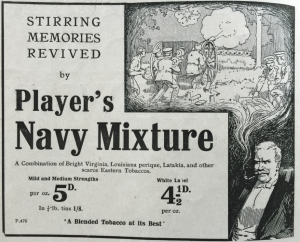
Tobacco advertisement from the cover of one of the weekly issues of ‘The History’, in Part 21, Volume 2.
At first, the publication was known as The Times History of the War but as the war progressed it would be known by the much more descriptive title of The Times History and Encyclopædia of the War. The earlier Parts 1-63 used the earlier title, and Parts 64-273 formed the later title. By war’s end the history/encyclopaedia would consist of twenty-one volumes. The individual parts of Volumes 1-21 were issued from 25 August 1914 to 27 July 1920, and Volume 22, published in 1921, formed a general index.
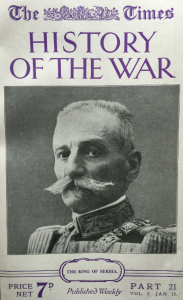
King Peter I of Serbia was featured on the front cover of Part 21 of Volume 2.
The earliest component parts featured graphic work on the front covers of the individual issues. Those in Volumes 1 and 2 featured the German Emperor, George V, Earl Kitchener, Field-Marshall Sir John French, Lt-Gen. Sir Douglas Haig, Peter I, General Gallieni, and Nicholas II, amongst others. The front cover was not always a statesman or military figure though…:

‘Homeless’ probably from communities in northern France or Belgium, featured on the front cover of Part 10, Volume 1.
Refugees fleeing assault on their communities were featured on a front cover in Volume 1, and in Volume 2 a cover features an enlistment poster ‘appealing’ for recruits after attacks on the east coast of England. It was an appeal to the ‘Women of Scarbro’ (Scarborough) to help ‘avenge slaughter of the innocent women and children’ of the town and ‘encourage’ men to ‘Enlist at Once’…
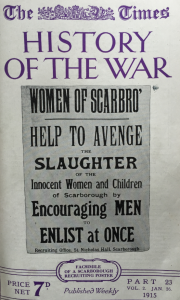
In the ‘East coast raid number’ this poster was featured on the front cover of Part 23, Volume 2.
The Preface to the first issue also commented on its maps. These were to be reproduced from those appearing in the pages of the daily newspaper – The Times – though ‘in some cases special maps will be prepared for particular purposes’. It went on, ‘special pains have been taken to secure their accuracy in every particular’.
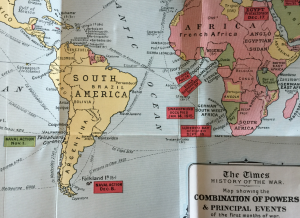
World map showing Africa and South America in 1915, appended to part 23, Volume 2, p.357.
An insert world map appended to Part 23 (February 1915), Volume 2, showed ‘the combination of powers and principal events of the first months of the war’. The map impressed on the reader how global the war had become, with naval action around the Falkland Islands in December 1914, naval action in the south eastern Pacific off Chile, and actions in south western Africa and west Africa.
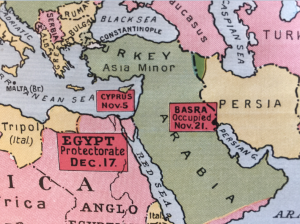
Same map showing action in the Middle East in 1915, appended to part 23, Volume 2, p.357.
The same map showed action taking place in Cyprus, Egypt, and Basra (then simply a city in the Ottoman Empire, rather than in the yet to be configured Iraq), and action in the Indian and western Pacific Oceans, and in China.
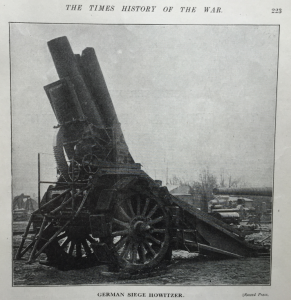
Siege Howitzer illustrated in Part 6, Volume 1, p.223.
Very early in the work too, it would become clear to the reader how ‘modern’ and ‘industrial’ warfare had become. The issues would feature pictures of aeroplanes of all warring parties, the siege howitzer and other heavy artillery, airships…:
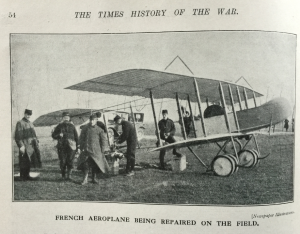
French aeroplane illustrated in Part 15, Volume 2, p.54.
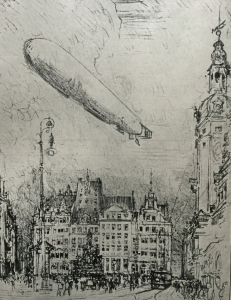
‘Zeppelin’ illustrated in Part 16, Volume 2, p.81.
and bombing…:
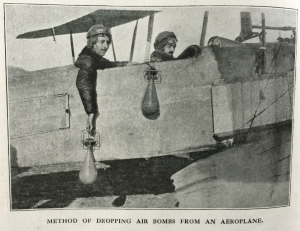
‘Air bombing’ illustrated in Part 18, Volume 2, p.196.
A further look at the content of The Times History and Encyclopædia of the War will be taken in the next few months.
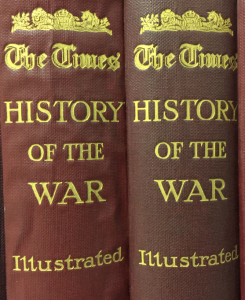
Dr. Graeme D. Eddie, Assistant Librarian Archives & Manuscripts, Centre for Research Collections (CRC)
